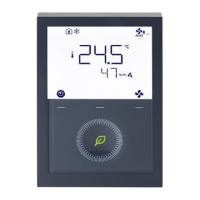● Control action can be changed from normally open (NO) and normally closed
(NC) via P151, P154 or P156.
● Each input X1, X2 or U1/X3 must be configured with a different function (1…5
& 9…13). Exception: 1, 2 or 3 inputs can be configured as fault (6) or monitor
input (7,8).
● X1 is factory-set to "External sensor" (1), X2 to "Not used" (0) or RDG200T &
RDG260T: "H/C changeover" (2), and U1/X3 to "Window contact" (3) or
RDG204KN & RDG264KN: "Not used" (0).
For more detailed information, see Application overview [➙ 43].
● For inputs X1, X2, or U1/X3, one physical switch can be used for up to 20
thermostats (parallel connection).
● In 4-pipe/2-stage application of RDG26..KN, U1 is fixed as DC output (YC2)
and cannot be set as input.
Caution! Do not mix X1/X2 and U1/X3.
● For sensors on inputs X1, X2, or U1/X3, the maximum cable length is 80 m.
4.11 Handling system faults
If the room temperature exceeds or drops below the measuring range, i.e. above
49 °C or below 0 °C, the limiting temperatures blink, e.g., 0 °C or 49 °C.
In addition, the heating output is activated if the current setpoint is not set to Off,
the thermostat is in heating mode and the temperature is below 0 °C.
For all other cases, no output is activated.
The thermostat resumes Comfort mode as soon as the temperature is within the
measuring range.
● If the built-in temperature or humidity sensor fails and no external temperature
sensor is connected, fault message Er1 is displayed on the thermostat. If
EEPROM is damaged, fault message Er2 is displayed on the thermostat.
Replace the thermostat to measure the room temperature.
● If the external / remote temperature sensor fails and no external sensor is
connected, if input X1/X2/U1 (RDG2..KN)/X3 (RDG2..T) is configured as AI
except room temp external sensor/return (AI), fault message Er3, Er4 or Er5 is
displayed on the thermostat. Check related sensor input terminals.

